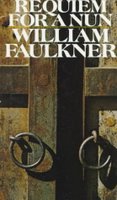William Faulkner: Requiem for a Nun.
 "The past is never dead. It's not even past."
"The past is never dead. It's not even past."Faulkner's sequel to his bestselling novel, Sanctuary, is definitely a minor-work compared to his pre-World War II fiction. The book is problematic in its experimental study of how the past affects the present. Faulkner uses prose and play-form; the prose sections are much like his earlier work - full of long-winded (yet beautifully written) stream-of-consciousness passages that chronicle the history of Jefferson, the county seat of his fictional Yoknapatawpha. The play, which practically stands completely separate from the prose sections, concerns Temple Drake eight years after her kidnapping by the gangster Popeye in Sanctuary.
Temple is now married to Gowan Stevens, a featured character from the book's prequel, and the mother of two children. When the play begins, we learn that the children's African-American nanny, Nancy, has been sentenced to death for the murder of Temple's six-month-old daughter. Nancy's defense attorney and Gowan's uncle, Gavin Stevens (a central character in Faulkner's Intruder in the Dust) comes to Temple the night before Nancy's execution and convinces her (through guilt) to accompany him to the governor of Mississippi to plead clemency for Nancy.
I found Faulkner's use of the play-form to tell Temple's story very interesting. Since the plot relied on her confessions, it seemed appropriate that Faulkner would limit his study of one of his most conflicted characters to dialogue. I'm not familiar with the play's history on the stage, and given its frequent three-page monologues and awkward framing, I can't imagine it would be very entertaining to watch, especially since so much of it focuses on Temple's experiences in Sanctuary.
Overall, it was an interesting read, although it cannot be compared to Faulkner's earlier work. I would recommend it to Faulkner fans or anyone who enjoyed Sanctuary and found Temple Drake to be as an intriguing and complicated character as I did.
B+


3 Comments:
I have not finished reading 'Requiem for a Nun' yet, but I will always remember it was one of the things I did on the day that Barack Obama took office as President of the United States of America.
The introductory part to Act One, with the foundation of Jefferson, contains the germ or the suggestion for 'Cien años de soledad' (One Hundred Years of Solitude) by Gabriel García Márquez. The expression 'hundred years' is used at least twice towards the end of the introduction to Act One.
"Because its fate is to stand in the hinterland of America: its doom is its longevity; like a man, its simple age is its own reproach, and after the hundred years, will become unbearable. But not for a little while yet; for a little while yet the sparrows and the pigeons: garrulous myriad and independent the one, the other uxorious and interminable, at once frantic and tranquil--until the clock strikes again which even after a hundred years, they still seem unable to get used to, bursting in one swirling explosion out of the belfry as though the hour, instead of merely adding one puny infinitesimal more to the long weary increment since Genesis, had shattered the virgin pristine air with the first loud ding-dong of time and doom."
The use of recurring names such as Sutpen and Compson (they appear in 'Absalom, Absalom!') was subsequently imitated by Juan Carlos Onetti, who had Larsen and Díaz Grey showing up in many of his novels set in the fictional city of Santa María.
I know Onetti was a confessed admirer of Faulkner's, and I imagine García Márquez is also one.
What I do not know is whether García Márquez is aware of Faulkner's influence over him, if he realised when he read Faulkner that Jefferson would become Macondo in his own output.
Pap!
nice review.
Post a Comment
<< Home